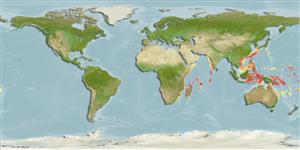Teleostei (teleosts) >
Anguilliformes (Eels and morays) >
Synaphobranchidae (Cutthroat eels) > Ilyophinae
Etymology: Dysomma: Greek, dys, dyo = two + Greek, omma = eye.
Environment: milieu / climate zone / depth range / distribution range
Ecology
Marine; benthopelagic; depth range 105 - 897 m (Ref. 106136). Tropical
Indo-West Pacific: off Madagascar, Taiwan, Philippines, and Solomon Islands;
Size / Weight / Age
Maturity: Lm ? range ? - ? cm
Max length : 35.7 cm TL male/unsexed; (Ref. 106136)
Short description
Identification keys | Morphology | Morphometrics
Vertebrae: 146 - 156. This species is distinguished by the following characters: no pectoral fin; dorsal-fin origin about 0.8-1 HL behind gill opening, predorsal length 16.5-19.1% TL; anus posterior, about 1.5 time of HL behind gill opening, preanal length 23.3-28.6% TL; trunk long, trunk length 14.3-17.7% TL; 2 intermaxillary teeth; upper jaw with 2 irregular rows of small blunt teeth; vomer with 2 or 3 (mainly 3) compound teeth; lower jaw single row of 4 or 5 small compound teeth followed by 1 or 2 irregular rows of small blunt teeth; short cirri on surfaces of chin and jaws; head pores: IO 4, SO 3, M 6 (1 with 7), POP 1, AD1, F 0, ST 0; lateral-line pores are large, prepectoral 5 or 6, total 9-11, the last at slightly beyond the gill opening posteriorly; MVF 18-27-153, total vertebrae 146-156 (Ref. 106136).
Life cycle and mating behavior
Maturity | Reproduction | Spawning | Eggs | Fecundity | Larvae
Smith, D.G., 1997. Synaphobranchidae. Cutthroat eels. p. 1658-1661. In K.E. Carpenter and V.H. Niem (eds.) FAO species identification guide for fishery purposes. The living marine resources of the WCP. Vol. 3. Batoid fishes, chimaeras and bony fishes part 1 (Elopidae to Linophrynidae). FAO, Rome. (Ref. 39639)
IUCN Red List Status (Ref. 130435: Version 2024-2)
Threat to humans
Harmless
Human uses
Fisheries: of no interest
Tools
Special reports
Download XML
Internet sources
Estimates based on models
Phylogenetic diversity index (Ref.
82804): PD
50 = 0.5001 [Uniqueness, from 0.5 = low to 2.0 = high].
Bayesian length-weight: a=0.00102 (0.00046 - 0.00225), b=3.06 (2.88 - 3.24), in cm total length, based on all LWR estimates for this body shape (Ref.
93245).
Trophic level (Ref.
69278): 3.8 ±0.3 se; based on size and trophs of closest relatives
Fishing Vulnerability (Ref.
59153): Low to moderate vulnerability (26 of 100).
